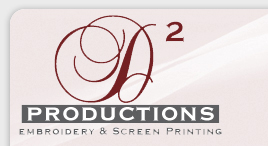POINTERS AND SUGGESTIONS
Let us help you understand Embroidery
Many times, we receive files that customers would like to have created for embroidery that will not stand up to the limitations of machine and thread. Unfortunately in this digital age, what looks good on a computer screen or on paper might not translate to quality embroidery.
The first thing to keep in mind is that Embroidery is normally a SPOT COLOR process. Embroidery thread is a solid that cannot be mixed with another thread to create a new color, much as can be done on a computer monitor or for offset printing. So those beautiful halftones and shadows that look so well on paper, may not always work for embroidery. While there are techniques that can be employed to mimic a gradient, these are not always effective depending on the design and the material the design will be sewn on.
The second thing to be aware of is that very small lettering does not reproduce well in Embroidery. Again because the thread is a solid, it takes multiple stitches to create an individual letter. In addition, the machine must move a minimum distance to complete a stitch. Otherwise, the multiple needle perforations in the same area will just create a hole in the garment. Additionally, font styles with serif’s will be even more difficult to reproduce. We recommend a minimum letter size of .25 inch for non serif fonts and a minimum of .375 inch for serif fonts. Keep in mind this is just a guideline. As more and more fonts are used by graphic artists, this recommendation becomes more and more of a generalization and a specific recommendation will depend on the font used.
The third thing to keep in mind is that the same file will sew differently on different material. A file that was created to sew on a woven garment, or on nylon, may not sew well if a knit garment is substituted. This is because the knit fabric will stretch each time the needle perforates the fabric. This stretching may cause colors not to register. It may also cause the logo to pucker on the garment, or it may appear that there are not be enough stitches to properly cover the material.
The final thing to keep in mind is that digitizing for $1.99 per thousand stitches may actually be more expensive than digitizing for $10.00 per thousand stitches. It takes time to create a quality file that will sew well on the type of garment you have selected. So, while you may be charged a minimal amount per stitch, all the digitizer needs to do is add more stitches to your file then would be needed or an even nastier trick is to use shorter stitches then needed. A normal underlay stitch should be in the range of 10mm to 12 mm long. We have seen files with underlay stitches as short as 2mm. We are sure you can do the math, but if a 2mm stitch is used in place of a 10mm stitch, the design now has 5 times the number of stitches needed to be properly run.
Any or all of these issues can be a real problem when a critical deadline has to be met. We as professionals understand the processes that are necessary to complete the project. Therefore, when we develop a project in-house, we know what the final outcome will be. It works every time!
We have a large knowledge base and would be happy to share it with you. Call us now so we can offer our expertise, we are ready to help you. Many contract embroiderers will just take the clients file and sew it and if there is a problem with the result, blame the file. We prefer to empower our clients with the knowledge of how to set-up files correctly. This will only give you the ability to educate your customer so they understand that quality embroidery is better than cheap embroidery.
Over the years we have helped our clients understand the Embroidery process. This knowledge has helped our clients to sell more and to educate their customers on the capabilities and limitations of the embroidery process. This has resulted in a rewarding working experience for our clients, their customers, and us. With our help, our clients have achieved greater outcomes and as a result, we have built long lasting relationships. |
